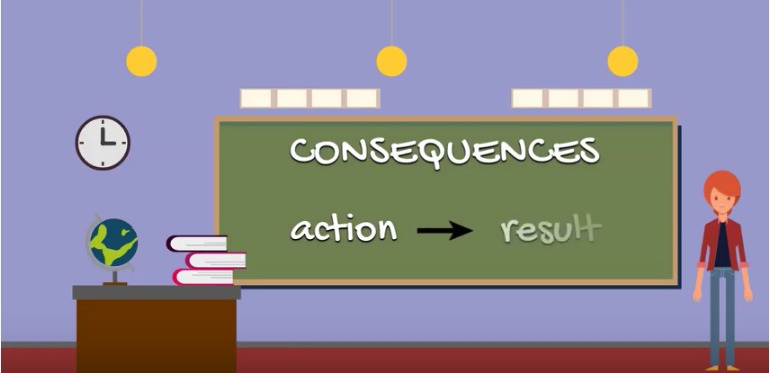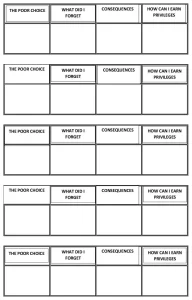CONSEQUENCES

CONSEQUENCES SHOULD BE A RESPONSE TO INAPPROPRIATE BEHAVIOUR.
IT SHOULD NEVER BE A PUNISHMENT
YOU CAN’T PUNISH A CHILD INTO BETTER BEHAVIOUR
OTHERWISE YOU WILL END UP WITH POWER STRUGGLES
TIPS ABOUT CONSEQUENCES
Instead of consequence stacking wait to give consequences when everyone is calm and then pick one thing that will be an effective motivator for your child.
What this means, in the simplest form, is that if you take something away, your child should know what specific behaviour he or she needs to show over a specified short-term period of time in order to earn it back.
They don’t always need to be harsh, just logical, so that they learn from the experience and are dealt with respectfully
For example, if he’s been breaking curfew, he needs to show that he can come in at an earlier time for seven days in a row before you raise the curfew back to a later time.
If consequences are not seen to be related and relevant to the behavior they can be seen as punishment ie. “You just broke your brothers favourite toy, there will be no iPad for a month”. There is no logical cause and effect or connection between breaking a toy and losing iPad privileges
Better problem-solving helps your child act differently. And in the future is the key to lasting behaviour change. Giving consequences and rewards is a tool that can be used to keep your child in agreeance.
CONSEQUENCES FOR KIDS THAT ACTUALLY WORK
Coming up with consequences for kids that work is not always easy, especially when you’re in the heat of the moment and you just need your kids to do what you ask (preferably without yelling)!
You need to find something that works and stick to it… if you want a behaviour to change.
If some of their consequences are not suitable that is where your common sense steps in. Consequences need to be acceptable to all parties.
Over the top consequences do not work because – (not consistent follow through, the whole family can get punished, its done in the heat of the moment
What you need to do is sit down have a family meeting
Then as a family, brainstorm some fitting consequences for misbehaviour. To help them see this in another way, you need to ask the following questions and have them fill in the answers in a little chart as outlined below:
- What are some behaviours we don’t allow in our family?
- What do I do (or not do) that leads to these behaviours?
- What are some of the natural consequences of these behaviours?
- What can I say and do to make them right? What can I do to show I am ready to start over?
Stick it up on the fridge and use it as a guide to help your kids go through the process of recognising poor choices, dealing with consequences, and making things right.
Now as soon as someone makes a poor choice, the children involved get a little slip of paper cut from a sheet that looks like this:
They get some time to think and fill in the blanks. Then talk about what they can do the next time they find themselves in a similar situation. Finally, the attempt to earn back privileges begins: sincere apologies need to be made (we’re working on this one!), and time is put toward the consequences. Sometimes this whole process can tak as long as five to six minutes, but sometimes it is as short as a minute.
REASONS I LIKE THIS APPROACH:
Cool Down: It has a surprisingly calming effect on everyone. The short time with the pencil and paper directs our children’s energy to reflecting and problem solving. It also gets us parents ready for a more helpful conversation than the one that might happen right as someone is “caught” and feeling defensive.
(Note: If more cool down time is needed, great. Don’t hand the ultra-agitated child a pencil and expect them it to be productive . . . or safe.)
Understanding: The child is doing the thinking, and she is recognizing how her choice is leading to the consequence. As a result, there are significantly fewer lengthy lectures from us these days. (The back of the paper also serves as a great place for writing compliments or drawing a nice picture for the offended.)
Problem Solving: This process is an opportunity for the child to realize not only what she did wrong, but what she can do next time. This is probably my favorite part—giving my child a tool to avoid easily avoidable problems to come.
Consistency: I love that with this system, discipline is not at the mercy of the time of day or a parent’s mood. There is more order and logic to it all compared to parents just trying to create a more dramatic punishment than the last time. We also have a list of practical, relevant, and reliable consequences that we can choose from and that the girls can expect (from our original chart).

